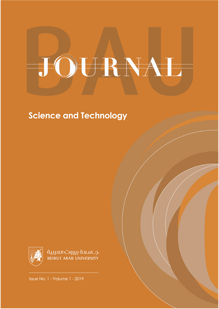Volume 5, Issue 1 (2023)
EDITORIAL (December 2023) | BAU Journal Science and Technology
This is the second issue of this year (2023) and comprises of eleven papers covering various Science and Engineering topics. The first paper authored by Kassem, Masri & Wehbe, examines the influence of steel jacketing on the performance of circular columns filled with concrete containing recycled aggregate. The paper contains both experimental and numerical data. It was concluded that using recycled aggregate concrete in steel columns can lead to cost saving and contributes towards sustainable environment. The second paper, authored by Alabbasi, F Moldoveanu & A Molgoveanu from Romania and Iraq, is a review paper on using Kinect sensor to classify human gender. The review covers the recent studies on the subject as well as other technologies in this domain. Accessible databases were used to classify people’s gender. The authors suggested using Kinect sensor can have a potential in classifying human gender. In the third paper, Abiad from BAU explores the reconstruction of fingertip injuries using V-Y volar advancement flap. The study was conducted on 30 patients, suffering from types III and IV injuries, where V-Y volar flap type was employed on 15 patients and for the rest of the patients neurovascular V-Y advancement flap type was used. It was concluded that V-Y volar advancement flap can be used in dorsally-directed tissue loss whereas, neurovascular V-Y advancement flap can be used in the volar-slanting tissue loss or the perpendicular fingertip amputation. Nanotechnology is the subject of the fourth paper where Bassam, Mezher& Khalil used bio-synthesis to produce magnesium nano-particles. Staphylococcus haemolyticus bacteria which was extracted from wastewater were used to sythesise the nano-particles. They examined the various parameters for the synthesis including; Mg nitrate solution, bacterial culture concentration, incubation time and temperature. According to the authors that magnesium nano-particles can be applied in different biological domains such as cancer and bacterial treatments. Paper no. five authored by Fayad, Baydoun & Soliman, assesses the water quality for two Lebanese ponds using the Canadian water quality index. Water quality assessments included temperature, turbidity, electrical conductivity (EC), total dissolved solids (TDS), pH, ammonia, nitrite, nitrate, chloride, hardness, sulfate, orthophosphate, total organic carbon, fluoride and E. coli. The electrical conductivity and total dissolved solids were found to be marginal, however, the other parameters were found to be within the permissible levels. A review on the effect of fine recycled concrete aggregates on the mechanical and durability properties of concrete, authored by Chour & Khatib, was the subject of the sixth paper. More than 160 references, including many recent ones, were consulted. Mechanical properties included, compressive strength, flexural and tensile strength, elastic modulus, shrinkage and creep. The physical and durability properties covered, permeability, chloride ingress, chemical attack and freeze-thaw resistance. This review should encourage practitioners to use fine recycled concrete aggregate in construction applications considering its limitations. In the seventh paper, Shamseddine, Aad, Oweini & Younes evaluates the characteristics of newly developed nano-silica doped with europium (H1) for the removal of Lead and Phosphate ions from contaminated solutions such as wastewater. The results of this study indicate that the uptake capacities for Lead and Phosphate were 24.8 and 55.6 mg/g respectively suggesting that nano-silica particles may be effective in removing other contaminants. Paper no. eight, authored by Abi-Saad, Younes, El-Dakdouki & Al-Oweini examines the use of polyoxometalates based on Molybdenum and Tungsten for the effective removal of methylene blue. Various parameters were considered during the systhesis including contact time, adsorbent dose, initial dye concentration, pH and temperature. It was found that using Molybdenum and Tungsten polyoxometalates was very efficient in removing methylene blue under acidic conditions within the first 10 minutes. They can also be used in other areas to reduce environmental pollution. Employing Digital Twins in distributed digital system (DSS) is the subject of the ninth paper which is authored by Itani, Abou Daher and Hammoud. This is a review paper where DSS metrics are presented based on recent research related to erasure coding. Also, the role of digital twins in monitoring DSS and assisting decision-making is highlighted. Future recommendations were identified for efficient DSS using Digital Twins. In the tenth paper authored by Shebli, Khatib & Elkordi, a preliminary investigation is conducted on the performance of mortar containing walnut ash (WNA) as a partial cement replacement. Cement was replaced with up to 15% WNA. Generally, increasing amounts of WNA caused an increase in the setting time, a reduction in compressive strength and increase in water absorption. It was concluded that an optimum amount of WNA can be used to partially replacing the cement without major effect on mortar properties. The eleventh paper authored by Hija, Shima & Arakaki from Japan and Qatar, compares and analyses the difference between advanced technological practices and traditional practices in Japan. The impact of technology on various activities has been explored including the farming community. The paper concludes that the technological advances can help addressing the social and economic issues and contribute towards a sustainable society. This issues covers various topics including environmental, technological and health issues which should be of interests to many researchers in different fields.
Jamal Khatib (CEng, FICE, FHEA)
Professor, Beirut Arab University, Lebanon | Emeritus Professor, University of Wolverhampton | Visiting Professor, Universities of La Rochelle, Shanghai Jin Tao University, Inner Mongolia University of Science and Technology
Articles
BEHAVIOR OF CONCRETE MIXES USING RECYCLED AGGREGATE CONFINED WITH STEEL SECTIONS
Latifa Sobhi Kassem, Adnan El-Masri, and Nour Webhi
HUMAN GENDER CLASSIFICATION USING KINECT SENSOR: A REVIEW
Hesham Adnan Alabbasi, Florica Moldoveanu, and Alin Moldoveanu
OPTIMIZATION OF THE BIO-SYNTHESIS OF MAGNESIUM NANOPARTICLES FROM STAPHYLOCOCCUS HAEMOLYTICUS: A PILOT STUDY
Mariam Bassam, Malak Mezher, and Mahmoud khalil
PRELIMINARY WATER QUALITY ASSESSMENT USING CANADIAN WATER QUALITY INDEX OF RAS EL-AIN PONDS, SOUTH LEBANON
Hussien Ali Fayad, Safaa Baydoun, and Mohamad Reda Soliman
THE EFFECT OF FINE RECYCLED CONCRETE AGGREGATES ON THE MECHANICAL AND DURABILITY PROPERTIES OF CONCRETE
Abbas Chour and Jamal Khatib
ASSESSING THE PERFORMANCE OF NEWLY DEVELOPED SILICA NANOPARTICLES AGAINST LEAD AND PHOSPHATE ION REMOVAL FROM CONTAMINATED SOLUTIONS USING ADSORPTION ISOTHERM
Hasan Shamseddine, Nour Abi Aad, Rami Oweini, and Ghassan Younes
MOLYBDENUM VERSUS TUNGSTEN BASED POLYOXOMETALATES FOR HIGHLY EFFECTIVE METHYLENE BLUE REMOVAL
Roula Abi Saad, Ghassan Younes, Mohammad H. El- Dakdouki, and Rami Al-Oweini
TOWARDS DIGITAL TWINS FOR OPTIMIZING METRICS IN DISTRIBUTED STORAGE SYSTEMS - A REVIEW
May Itani, Layal Abu Daher, and Ahmad Hammoud
THE EFFECT OF WALNUT SHELL ASH ON THE PROPERTIES OF CEMENT PASTE AND MORTAR: A STUDY ON PARTIAL REPLACEMENT OF CEMENT
Ali Shebli, Jamal Khatib, and Adel Elkordi
INTEGRATING TECHNOLOGY AND TRADITIONAL SYSTEMS IN REGIONAL REVITALISATION; INSIGHTS FROM JAPANESE PRACTICES
Fathelalem Ali Hija, Yasuki Shima, and Yuji Arakaki


